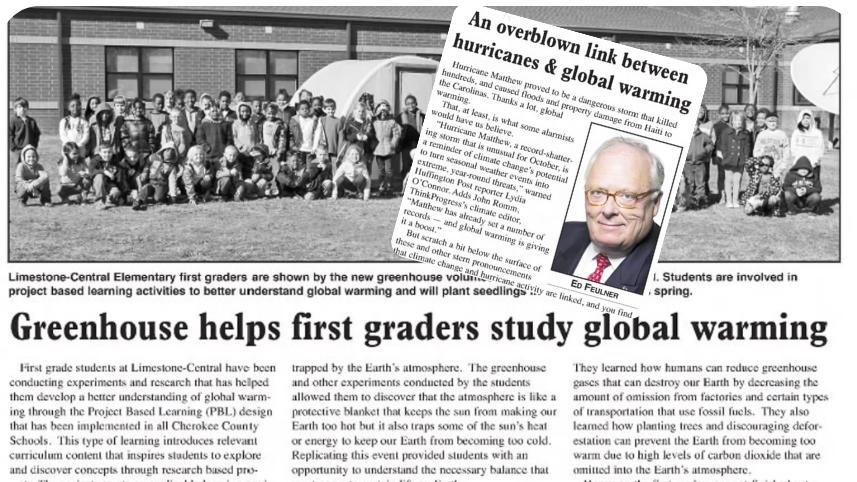For the culminating project of the 2020 Graduate Student Science Outreach Fellowship, fellows Catherine Henry and Abigail Howell joined me and NCSE staff member Emma Doctors in pursuing a research project about local news coverage of climate change, using newspapers from our local communities. We focused on three newspapers from three states — Arizona, Michigan, and North Carolina — that not only reflect our current places of residence but are also considered purple states. Using LexisNexis and Newspapers.com, we analyzed trends in covering climate change over the past 40 years. We searched all types of articles (including opinion pieces and wire stories), since most casual readers would probably not differentiate between the various types. Though we hope to publish many of these results more formally in the future, some of our interim findings seem worth sharing now.
One of our main goals for the project was to understand how the portrayal of climate change had changed over time. Therefore, in addition to “global warming” and “climate change,” we looked at 18 other key words and phrases that correlate with environmental issues, finding strong trends that explain how environmental issues were discussed in different decades. In the 1980s, the most common environmental term across all newspapers was “the greenhouse effect,” representing a scientific framing of a topic that was gaining public attention and interest.
In the 1990s, by contrast, climate issues were more frequently addressed using broad conservation themes. Terms like “biodiversity,” “environmental destruction” and “endangered species” were common during this decade, along with “environmentalists” and “Mother Earth.” These reflect a general shift away from the pure science-based coverage of the 1980s towards scientific coverage with more emotional appeals. Though these messages were successful in fueling an environmental movement, we know from work on climate change communication that this kind of framing, while effective, can be problematic when attempting to move people to take action. By focusing on the loss of certain endangered species, these messages encouraged people to focus on saving one species, as opposed to taking stock of the more systemic issues affecting whole ecosystems. In addition, they diverted readers’ attention away from their communities and towards what could be lost without action. Climate change communication research suggests that making issues local and focusing on what people can gain by taking action create much stronger narratives.
The 2000s again saw a shift in climate change coverage, focusing on systemic issues using such terms as “climate crisis,” “renewable resources,” and “sustainability.” These often involved individualist messages, such as what the readers can do to take action locally. The time period from 2000 to 2010 showed climate messages with some of the closest alignment towards modern-day best practices for climate communication.
In addition, this time period had perhaps the most interesting trend from our analysis. Looking solely at the sum of global warming and climate change coverage, we saw an increase in news articles about these topics between 1991 and 2010, before coverage dropped off sharply in the 2011-2015 time period. Though coverage has again increased between 2016 and 2020, local news, unlike national news, has not risen to pre-2010 levels. Mapping major climate events, such as environmental disasters and key pieces of climate policy, onto the timeline reveals no clear reason why the early 2010s saw such a huge drop-off. Major events, such as the Paris Agreement, happened during this time, providing plenty of newsworthy items. This time period also coincided with an increase in climate skepticism relative to previous decades. We are still exploring the role that local news plays in people’s perceptions about climate change — there is some evidence to suggest that local news may have included proportionately more negative news articles during the early 2010s.
Across the years we’ve examined, the climate change education article published in 2016 in The Gaffney Ledger is one of only a handful of articles in the three states’ newspapers that portrayed global warming as sound science. This is a shame, because the article is a great example of effective climate communication. The authors not only make the issue local but also focus on what the students are gaining and appeal to the reader’s values by emphasizing the importance of educating future generations. Local newspapers can use their considerable public trust to build local acceptance of climate change through articles like these. Though local news coverage still lags behind national coverage, it has untapped potential to increase public understanding and acceptance of climate change science, which projects like ours are beginning to uncover.


